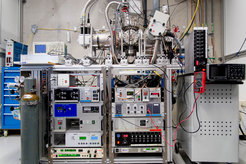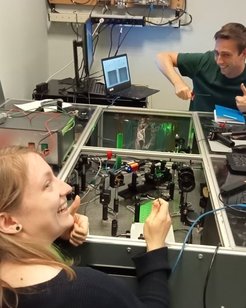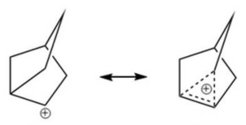Projects
The Max Planck- Radboud University Center for Infrared Free Electron Laser Spectroscopy seeks to enhance opportunities for collaborative activities between investigators of the FHI-FEL facility and the FELIX Laboratory through funding of joint research projects. Financial support will be provided for hiring postdoctoral researchers for a period of up to 2 years and PhD students up to 2 years, maximum. Employment conditions are determined by the applicable laws and regulations of the hosting laboratory.
Projects must have clear relevance to areas supported by the Center. A high degree of interaction between FHI and HFML-FELIX investigators is a mandatory requirement for further consideration of the proposal. The written proposal should not exceed 3 pages (A4) and provide key information on the planned research, the envisioned collaboration and requested funding.
Center members are eligible for submission of proposals, which can be submitted any time. The Governing Board will evaluate the received proposals and prioritize them based on scientific quality and added value of the collaboration. Funds will be distributed according to availability, taking into account the global balance between FHI and HFML-FELIX contributions. Funding decisions will be communicated within three months after submission.
Prebiotic chemistry at work in space – a joint experimental and theoretical study
Project leaders: Sandra Brünken (FELIX Infrared and Terahertz Spectroscopy, RU Nijmegen) & Jésus Pérez-Ríos (Theoretical Atomic, Molecular and Optical Physics, FHI Berlin) PhD students: Hunarpreet Kaur (RU Nijmegen) & Weiqi Wang (FHI Berlin)

The path to life as we know it on Earth is paved by an ever-increasing complexity of organic molecules. The question if and how prebiotic synthesis started in the depths of our universe is central in the origins of life puzzle – and one of the grand challenges in the field of astrochemistry. To date only fragmentary and merely a priori knowledge exists on the role and efficiency of chemical pathways to complexity. The first key step towards understanding prebiotic synthesis is the exploration of formation pathways of simple sugars, amino acids, and peptides. The core of this proposal is to provide a systematic experimental and theoretical study of the underlying processes for gas-phase synthesis of these elementary prebiotic molecules. For this we will combine advanced laboratory-based experiments at FELIX with high-level quantum-chemical calculations and novel molecular dynamics approaches developed at FHI.
Shaken, not stirred: how phonons can switch the order in ferroics
Project leaders: Andrei Kirilyuk (Condensed Matter Physics, RU Nijmegen), Alexander Paarmann (Lattice Dynamics, FHI Berlin) and Sebastian F. Maehrlein (THz Structural Dynamics, FHI Berlin) PhD students: Daniel Lourens (RU Nijmegen) and Dorothée Mader (FHI Berlin)

In nature, resonance phenomena can be broadly found enabling energy efficient processes. Therefrom inspired, we investigate how vibrational resonances of solids can be employed to trigger ultrafast, but permanent, switching of material properties, specifically magnetic or electronic properties. To achieve and microscopically understand this non-invasive control of the responsible order parameters, we study the role of phonons in dynamic symmetry breaking, their anharmonic coupling and their general impact on the ferroic order. For resonant and intense infrared (IR) excitation of specific lattice modes, we employ the tailored capabilities of FELIX/FELICE, FHI FEL and a complementary FHI tabletop MIR high-field source. We follow the ensuing ultrafast switching events by synchronized femtosecond laser pulses enabling spatio-temporal resolution via polarization resolved and nonlinear microscopy. Overall, these highly anticipated insights may provide a novel handle for energy efficient and stable reversal of magnetization or ferroelectric polarization with tailored single IR light pulses.
Carbocations in organic and astrochemistry: investigation by IR ion spectroscopy
Project leaders: Jos Oomens (Molecular Structure and Dynamics, RU Nijmegen) and Gert von Helden (Biomolecules in the Gas Phase, FHI Berlin) PhD students: Laura Finazzi (RU Nijmegen) & Katja Ober (FHI Berlin)

The ability to form various types of stable covalent bonds, but at the same time undergo facile chemical conversions, explains the central place that carbon occupies within the chemical sciences. In many organic chemical reactions, carbocationic species have been invoked as intermediates and these have indeed been identified in reaction mixtures. But carbocations are also often encountered in the gas phase, for instance in mass spectrometric analyses or as constituents of the interstellar medium. The molecular structure of carbocations and whether the charge is localized or delocalized, has been the topic of lively debates. The medium, condensed or gaseous, may crucially determine this structure, fuelling the discussion. This project spectroscopically investigates carbocation structures in the complete isolation of the vacuum of a mass spectrometer.
Dynamics of vibrational energy dissipation in metal cluster complexes
Project leaders: Joost Bakker (Condensed Matter Physics, RU Nijmegen) and André Fielicke (Spectroscopy and chemistry of metal cluster complexes, FHI Berlin) PhD students: Rutger Zijlstra (RU Nijmegen) & vacancy (FHI Berlin)
As for many chemical reactions, the course of a surface-assisted reaction not only depends on the overall energetics but also on kinetic effects like the speed of bond formation or breaking and the transport of matter and energy in the reacting system. In that regard, an important aspect for molecules adsorbed on surfaces is also the lifetime of their vibrational excitations that strongly depend on the type and strength of bonding within the system. The project aims to study such vibrational energy flow from molecule to the surface in an idealized model system of a transition metal cluster with an adsorbed molecule. For this we develop experimental methods to study the vibrational excitation dynamics in isolated cluster complexes in the gas phase using the IR-FELs FELIX and FHI-FEL.
Two-by-two: Establishing two-color infrared free-electron laser experiments
Project leaders: Nils Dessmann (Pump-Probe Spectroscopy, RU Nijmegen), Alexander Paarmann (Lattice Dynamics, FHI Berlin). PhD students vacant (RU Nijmegen) & Akash-Chandra Behera (FHI Berlin).
Both facilities, FELIX and the FHI FEL, recently commissioned a novel type of synchronized two-color infrared lasing at their facilities, where both infrared colors can be tuned independently. This unique experimental capability opens up a whole new realm of potential scientific questions that could not be accessed previously. This project aims to establish two-color experiments in two complementary ways – implementing ultrafast time-resolved two-color pump-probe spectroscopy on the one hand, and two-color infrared nonlinear microscopy on the other hand, here focusing on solid-state systems. By combining the expertise from both facilities, we expect rapid development of these novel methodologies, opening up many opportunities for new experiments in the future.
Identification of Novel Biomarkers for Inherited Metabolic Disorders using Infrared Ion Spectroscopy
Project leaders: Jonathan Martens and Jos Oomens (Molecular Structure and Dynamics, RU Nijmegen) and Gert von Helden (Biomolecules in the Gas Phase, FHI Berlin) Postdoc: Hidde Elferink (RU Nijmegen)
Inherited metabolic disorders result from genetic defects and lead to enzyme deficiencies that cause the accumulation or depletion of key metabolites. This research project aims at unravelling disease mechanisms and identifying novel biomarkers for disorders such as galactosemia using advanced infrared spectroscopy techniques. Infrared ion spectroscopy (IRIS) will be combined with liquid chromatography–mass spectrometry (LC-MS) to detect and precisely characterize disease-specific metabolites.The study will further explore the biochemical pathways and biological roles of these metabolites, providing insights into the patho-mechanisms of inherited metabolic disorders and possible new pathways for improved diagnostics and treatment strategies.


